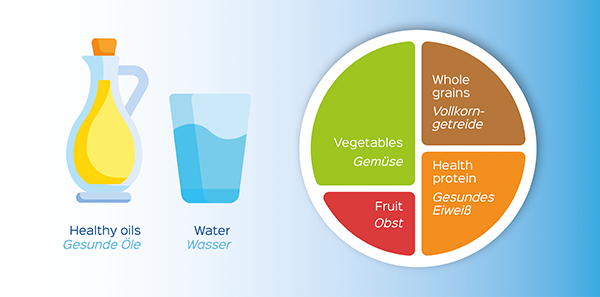
What foods should you eat every day? How should you structure them? What are the right proportions to get all the nutrients in your body?
The Harvard Plate, a method created by expert nutritionists at Harvard University, is designed to answer these questions, raise awareness of the importance of a proper diet and combat diseases related to poor nutritional habits, such as cancer, diabetes and cardiovascular problems.
The intestine protects the immune system, mental health and is related to cardiovascular health, among many other functions. The key to its proper functioning is to follow a healthy, varied and balanced diet that allows you to feel active throughout the day.
What is the Harvard Plate?
It is a simple and informative tool that replaces the nutritional pyramid. This method, unlike the traditional one, is more practical, for daily use and more specific in terms of quantities. Moreover, it radically eliminates products for occasional consumption, such as ultra-processed products, soft drinks, alcohol, trans fats and fried foods, in favour of healthy products and EVOO as the main fat.
The infographic simulates a plate divided into four zones:
- Fruit and vegetables on half of the plate. The key is to eat a lot of variety.
- Carbohydrates on a quarter of the plate. Wholemeal flour and rice, quinoa, buckwheat and root vegetables are highly recommended. It is advisable to limit white bread and rice, as they are refined.
- Protein on a quarter of the plate. This includes fish, poultry, pulses, nuts… Red meat, cheese, bacon, cold meats and other processed meats should be reduced as they are high in fat and have little nutritional value.
What about drinks? Water is the main source of hydration. Coffee or tea is also permitted, but with little or no sugar. On the other hand, dairy products are limited (1-2 per day).
This pattern does not have to be followed religiously, but it aims to serve as a reference to calculate the quantities of foods in stews, stocks and even meals that include various courses.
What are the benefits?
- Simpler, clearer and easier, since you don’t have to weigh foods.
- Key to following a varied diet, since it includes all the foods required in a meal.
- Limits carbohydrates and encourages their correct consumption for a healthy diet.
- Encourages water consumption.
- Child-friendly, since it is a fun way of teaching them the importance of a balanced diet.
This should be accompanied by adequate exercise and rest in order to lead a healthy lifestyle.
The Harvard Plate is not a diet in itself, but rather a basic guide on how to organise and combine foods. If you have any questions, contact a specialist dietitian-nutritionist who can assess your needs.













